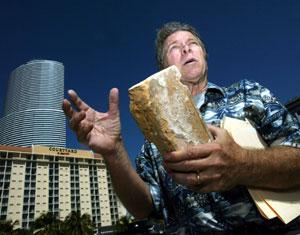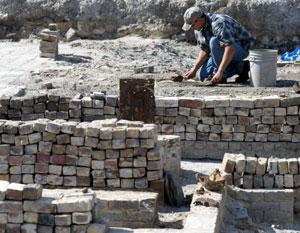
See how Mnemotrix Systems, Inc. assisted AHC with GPR in unearthing
dimensions of the Royal Palm Hotel, in the One Miami Pre-construction
Archaeology Project
Posted in the Miami Herald on Wed, Apr. 21, 2004
$100 buys you a brick of hotel built by FlaglerHistory buffs can buy a piece of the famed Royal Palm Hotel, demolished 74 years ago. Archaeologists exploring a downtown Miami site will sell Royal Palm bricks for $100.BY MARTIN MERZER mmerzer@herald.com Take home a piece of the Royal Palm Hotel, a chunk of 19th century South Florida grandeur. The cost -- about $100. Archaeologists working in the skyscraper shadows of downtown Miami are discovering, dusting and displaying ever-larger foundational sections of the once-magnificent hotel, opened by railroad magnate Henry Flagler in 1897 and razed in 1930. Now, they plan to sell -- one by one -- 1,500 yellow and red bricks gently pried from the hotel's lower walls, newly unearthed from below the asphalt of a parking lot north of the Dupont Plaza hotel. Through tax-deductible donations of $100 per brick, project managers hope to raise at least $150,000 for analysis and exhibition of the thousands of much older artifacts recovered from the sprawling site. Some of the discoveries reach back thousands of years, when Tequesta Indians ranged through what is now Miami-Dade and Broward counties. ''It's important for a community to understand its history,'' said Greg Saldaņa, an architectural historian who was working on the site Tuesday. ``This, right here, is a record of our past.'' Each brick can be kept by the buyer and will include a commemorative plaque. Sales should start by June. Proceeds will go to the nonprofit, Davie-based Archaeological and Historical Conservancy, which is running the six-acre dig. The area, consisting of three adjacent parking lots, will be developed into stores, offices and luxury condominiums. But for now . . . . ''This is the largest archaeological project ever conducted in South Florida -- by far,'' said archaeologist Bob Carr, director of the conservancy, who briefed Miami's Historic and Environmental Preservation Board about the scope of the project Tuesday. ``Every day, we're finding pieces of the area's history.'' That includes slivers of Tequesta pottery, shards of primitive tools and about 15 rusted room keys from the Royal Palm. In September, Carr and his team reported that they also are finding human remains. They now have recovered bone fragments from at least five members of the Tequesta tribe that flourished in South Florida for 2,500 years but disappeared by 1763, ravaged by European expansion and the germs carried by explorers.
A CREEKThe remains were found in various corners of the site but mostly in natural sinkholes and along the banks of a creek that trickled through the area 10,000 years ago -- another startling discovery.''It's pretty hard to imagine a creek here,'' Carr said, surrounded by hotels and high-rise office buildings. The Metromover swooshed overhead, cars rolled along Southwest Third Street and jetliners roared away from the airport. The human bones were ''highly disturbed,'' said Carr, who helped discover the Miami Circle stone carving on the south bank of the Miami River in 1998. That means the bones had been scattered over the centuries by previous builders. In addition to the Royal Palm, the area served as the site of early Spanish forts, the 19th century Fort Dallas and a nearby Tequesta cemetery. ''We now know that the cemetery extended well into this site,'' Carr said. The bones were reported to state officials, Carr said. In general, state law and policy require that human remains are treated with respect and reinterred as closely as possible to the place of discovery. ''That is what we will do,'' he said.
The radar helps archaeologists and other specialists ''see'' underground structures and other promising targets. The hotel, which stretched 600 feet along the Miami River's north bank, fueled the area's tourism industry. Five stories tall with a sixth-floor salon, it featured the city's first electric lights, elevators and swimming pool.
PREVIOUS SALEGrievously damaged by the 1926 hurricane, it was demolished four years later. Back then, an ad in The Herald also offered Royal Palm bricks for sale. The price: $14. For each 1,000 bricks.On Tuesday, Saldaņa, the architectural historian, stood on the terra cotta floor of what was once a corridor through the basement of the Royal Palm. He made measurements and drew sketches and marveled at what he was seeing and doing. This was it, right here, right where he stood. The Royal Palm Hotel. And why was this important? ''This is really about managing cultural resources,'' Saldaņa said. ``We are getting to examine an artifact in site, in its context. It's important to record it before the site is developed.''
|


